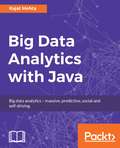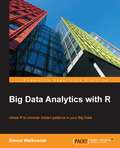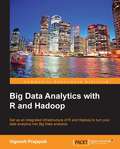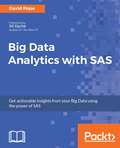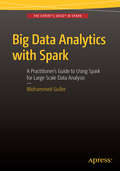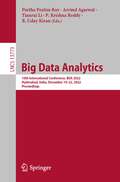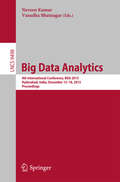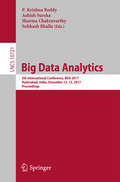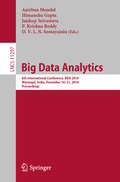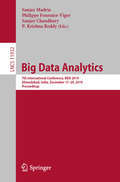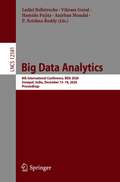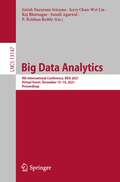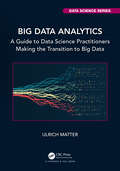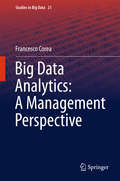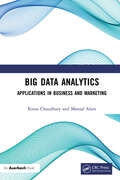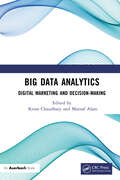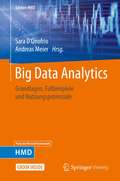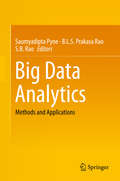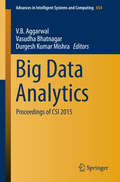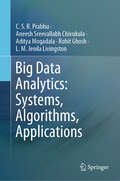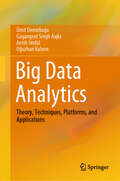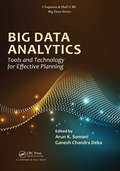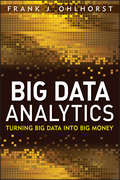- Table View
- List View
Big Data Analytics with Java
by Rajat MehtaLearn the basics of analytics on big data using Java, machine learning and other big data tools About This Book • Acquire real-world set of tools for building enterprise level data science applications • Surpasses the barrier of other languages in data science and learn create useful object-oriented codes • Extensive use of Java compliant big data tools like apache spark, Hadoop, etc. Who This Book Is For This book is for Java developers who are looking to perform data analysis in production environment. Those who wish to implement data analysis in their Big data applications will find this book helpful. What You Will Learn • Start from simple analytic tasks on big data • Get into more complex tasks with predictive analytics on big data using machine learning • Learn real time analytic tasks • Understand the concepts with examples and case studies • Prepare and refine data for analysis • Create charts in order to understand the data • See various real-world datasets In Detail This book covers case studies such as sentiment analysis on a tweet dataset, recommendations on a movielens dataset, customer segmentation on an ecommerce dataset, and graph analysis on actual flights dataset. This book is an end-to-end guide to implement analytics on big data with Java. Java is the de facto language for major big data environments, including Hadoop. This book will teach you how to perform analytics on big data with production-friendly Java. This book basically divided into two sections. The first part is an introduction that will help the readers get acquainted with big data environments, whereas the second part will contain a hardcore discussion on all the concepts in analytics on big data. It will take you from data analysis and data visualization to the core concepts and advantages of machine learning, real-life usage of regression and classification using Naive Bayes, a deep discussion on the concepts of clustering,and a review of simple neural networks on big data using deepLearning4j or plain Java Spark code. This book is a must-have book for Java developers who want to start learning big data analytics and want to use it in the real world. Style and approach The approach of book is to deliver practical learning modules in manageable content. Each chapter is a self-contained unit of a concept in big data analytics. Book will step by step builds the competency in the area of big data analytics. Examples using real world case studies to give ideas of real applications and how to use the techniques mentioned. The examples and case studies will be shown using both theory and code.
Big Data Analytics with R
by Simon WalkowiakUtilize R to uncover hidden patterns in your Big Data About This Book * Perform computational analyses on Big Data to generate meaningful results * Get a practical knowledge of R programming language while working on Big Data platforms like Hadoop, Spark, H2O and SQL/NoSQL databases, * Explore fast, streaming, and scalable data analysis with the most cutting-edge technologies in the market Who This Book Is For This book is intended for Data Analysts, Scientists, Data Engineers, Statisticians, Researchers, who want to integrate R with their current or future Big Data workflows. It is assumed that readers have some experience in data analysis and understanding of data management and algorithmic processing of large quantities of data, however they may lack specific skills related to R. What You Will Learn * Learn about current state of Big Data processing using R programming language and its powerful statistical capabilities * Deploy Big Data analytics platforms with selected Big Data tools supported by R in a cost-effective and time-saving manner * Apply the R language to real-world Big Data problems on a multi-node Hadoop cluster, e.g. electricity consumption across various socio-demographic indicators and bike share scheme usage * Explore the compatibility of R with Hadoop, Spark, SQL and NoSQL databases, and H2O platform In Detail Big Data analytics is the process of examining large and complex data sets that often exceed the computational capabilities. R is a leading programming language of data science, consisting of powerful functions to tackle all problems related to Big Data processing. The book will begin with a brief introduction to the Big Data world and its current industry standards. With introduction to the R language and presenting its development, structure, applications in real world, and its shortcomings. Book will progress towards revision of major R functions for data management and transformations. Readers will be introduce to Cloud based Big Data solutions (e.g. Amazon EC2 instances and Amazon RDS, Microsoft Azure and its HDInsight clusters) and also provide guidance on R connectivity with relational and non-relational databases such as MongoDB and HBase etc. It will further expand to include Big Data tools such as Apache Hadoop ecosystem, HDFS and MapReduce frameworks. Also other R compatible tools such as Apache Spark, its machine learning library Spark MLlib, as well as H2O. Style and approach This book will serve as a practical guide to tackling Big Data problems using R programming language and its statistical environment. Each section of the book will present you with concise and easy-to-follow steps on how to process, transform and analyse large data sets.
Big Data Analytics with R and Hadoop
by Vignesh PrajapatiBig Data Analytics with R and Hadoop is a tutorial style book that focuses on all the powerful big data tasks that can be achieved by integrating R and Hadoop.This book is ideal for R developers who are looking for a way to perform big data analytics with Hadoop. This book is also aimed at those who know Hadoop and want to build some intelligent applications over Big data with R packages. It would be helpful if readers have basic knowledge of R.
Big Data Analytics with SAS
by David PopeLeverage the capabilities of SAS to process and analyze Big Data About This Book • Combine SAS with platforms such as Hadoop, SAP HANA, and Cloud Foundry-based platforms for effecient Big Data analytics • Learn how to use the web browser-based SAS Studio and iPython Jupyter Notebook interfaces with SAS • Practical, real-world examples on predictive modeling, forecasting, optimizing and reporting your Big Data analysis with SAS Who This Book Is For SAS professionals and data analysts who wish to perform analytics on Big Data using SAS to gain actionable insights will find this book to be very useful. If you are a data science professional looking to perform large-scale analytics with SAS, this book will also help you. A basic understanding of SAS will be helpful, but is not mandatory. What You Will Learn • Configure a free version of SAS in order do hands-on exercises dealing with data management, analysis, and reporting. • Understand the basic concepts of the SAS language which consists of the data step (for data preparation) and procedures (or PROCs) for analysis. • Make use of the web browser based SAS Studio and iPython Jupyter Notebook interfaces for coding in the SAS, DS2, and FedSQL programming languages. • Understand how the DS2 programming language plays an important role in Big Data preparation and analysis using SAS • Integrate and work efficiently with Big Data platforms like Hadoop, SAP HANA, and cloud foundry based systems. In Detail SAS has been recognized by Money Magazine and Payscale as one of the top business skills to learn in order to advance one's career. Through innovative data management, analytics, and business intelligence software and services, SAS helps customers solve their business problems by allowing them to make better decisions faster. This book introduces the reader to the SAS and how they can use SAS to perform efficient analysis on any size data, including Big Data. The reader will learn how to prepare data for analysis, perform predictive, forecasting, and optimization analysis and then deploy or report on the results of these analyses. While performing the coding examples within this book the reader will learn how to use the web browser based SAS Studio and iPython Jupyter Notebook interfaces for working with SAS. Finally, the reader will learn how SAS's architecture is engineered and designed to scale up and/or out and be combined with the open source offerings such as Hadoop, Python, and R. By the end of this book, you will be able to clearly understand how you can efficiently analyze Big Data using SAS. Style and approach The book starts off by introducing the reader to SAS and the SAS programming language which provides data management, analytical, and reporting capabilities. Most chapters include hands on examples which highlights how SAS provides The Power to Know©. The reader will learn that if they are looking to perform large-scale data analysis that SAS provides an open platform engineered and designed to scale both up and out which allows the power of SAS to combine with open source offerings such as Hadoop, Python, and R.
Big Data Analytics with Spark: A Practitioner's Guide to Using Spark for Large Scale Data Analysis
by Mohammed GullerThis book is a step-by-step guide for learning how to use Spark for different types of big-data analytics projects, including batch, interactive, graph, and stream data analysis as well as machine learning. It covers Spark core and its add-on libraries, including Spark SQL, Spark Streaming, GraphX, MLlib, and Spark ML. Big Data Analytics with Spark shows you how to use Spark and leverage its easy-to-use features to increase your productivity. You learn to perform fast data analysis using its in-memory caching and advanced execution engine, employ in-memory computing capabilities for building high-performance machine learning and low-latency interactive analytics applications, and much more. Moreover, the book shows you how to use Spark as a single integrated platform for a variety of data processing tasks, including ETL pipelines, BI, live data stream processing, graph analytics, and machine learning. The book also includes a chapter on Scala, the hottest functional programming language, and the language that underlies Spark. You'll learn the basics of functional programming in Scala, so that you can write Spark applications in it. What's more, Big Data Analytics with Spark provides an introduction to other big data technologies that are commonly used along with Spark, such as HDFS, Avro, Parquet, Kafka, Cassandra, HBase, Mesos, and so on. It also provides an introduction to machine learning and graph concepts. So the book is self-sufficient; all the technologies that you need to know to use Spark are covered. The only thing that you are expected to have is some programming knowledge in any language. What you'll learn Write Spark applications in Scala for processing and analyzing large-scale data Interactively analyze large-scale data with Spark SQL using just SQL and HiveQL Process high-velocity stream data with Spark Streaming Develop machine learning applications with MLlib and Spark ML Analyze graph-oriented data and implement graph algorithms with GraphX Deploy Spark with the Standalone cluster manger, YARN, or Mesos Monitor Spark applications Who this book is for Big Data Analytics with Spark is for data scientists, business analysts, data architects, and data analysts looking for a better and faster tool for large-scale data analysis. It is also for software engineers and developers building Big Data products. Table of Contents 1. Big Data Technology Landscape 2. Programming in Scala 3. Spark Core 4. Interactive Data Analysis with Spark Shell 5. Writing a Spark Application 6. Spark Streaming 7. Spark SQL 8. Machine Learning with Spark 9. Graph Processing with Spark 10. Cluster Managers 11. Monitoring
Big Data Analytics: 10th International Conference, BDA 2022, Hyderabad, India, December 19–22, 2022, Proceedings (Lecture Notes in Computer Science #13773)
by Arvind Agarwal Tianrui Li Partha Pratim Roy P. Krishna Reddy R. Uday KiranThis book constitutes the proceedings of the 10th International Conference on Big Data Analytics, BDA 2022, which took place in Hyderabad, India, in December 2022.The 7 full papers and 7 short papers presented in this volume were carefully reviewed and selected from 36 submissions. The book also contains 4 keynote talks in full-paper length. The papers are organized in the following topical sections: Big Data Analytics: Vision and Perspectives; Data Science: Architectures; Data Science: Applications; Graph Analytics; Pattern Mining; Predictive Analytics in Agriculture.
Big Data Analytics: 4th International Conference, BDA 2015, Hyderabad, India, December 15-18, 2015, Proceedings (Lecture Notes in Computer Science #9498)
by Naveen Kumar Vasudha BhatnagarThis book constitutes the refereedconference proceedings of the Fourth International Conference on Big DataAnalytics, BDA 2015, held in Hyderabad, India, in December 2015. The 9 revised full papers and 9invited papers were carefully reviewed and selected from 61 submissions andcover topics on big data: security and privacy; big data in commerce; big data:models and algorithms; and big data in medicine.
Big Data Analytics: 5th International Conference, BDA 2017, Hyderabad, India, December 12-15, 2017, Proceedings (Lecture Notes in Computer Science #10721)
by P. Krishna Reddy, Ashish Sureka, Sharma Chakravarthy and Subhash BhallaThis book constitutes the refereed conference proceedings of the 5th International Conference on Big Data Analytics, BDA 2017, held in Hyderabad, India, in December 2017. The 21 revised full papers were carefully reviewed and selected from 80 submissions and cover topics on big data analytics, information and knowledge management, mining of massive datasets, computational modeling, data mining and analysis.
Big Data Analytics: 6th International Conference, BDA 2018, Warangal, India, December 18–21, 2018, Proceedings (Lecture Notes in Computer Science #11297)
by Jaideep Srivastava P. Krishna Reddy Anirban Mondal Himanshu Gupta D. V. L. N. SomayajuluThis book constitutes the refereed proceedings of the 6th International Conference on Big Data analytics, BDA 2018, held in Warangal, India, in December 2018. The 29 papers presented in this volume were carefully reviewed and selected from 93 submissions. The papers are organized in topical sections named: big data analytics: vision and perspectives; financial data analytics and data streams; web and social media data; big data systems and frameworks; predictive analytics in healthcare and agricultural domains; and machine learning and pattern mining.
Big Data Analytics: 7th International Conference, BDA 2019, Ahmedabad, India, December 17–20, 2019, Proceedings (Lecture Notes in Computer Science #11932)
by Sanjay Madria P. Krishna Reddy Sanjay Chaudhary Philippe Fournier-VigerThis book constitutes the refereed proceedings of the 7th International Conference on Big Data analytics, BDA 2019, held in Ahmedabad, India, in December 2019.The 25 papers presented in this volume were carefully reviewed and selected from 53 submissions. The papers are organized in topical sections named: big data analytics: vision and perspectives; search and information extraction; predictive analytics in medical and agricultural domains; graph analytics; pattern mining; and machine learning.
Big Data Analytics: 8th International Conference, BDA 2020, Sonepat, India, December 15–18, 2020, Proceedings (Lecture Notes in Computer Science #12581)
by Ladjel Bellatreche Hamido Fujita P. Krishna Reddy Anirban Mondal Vikram GoyalThis book constitutes the proceedings of the 8th International Conference on Big Data Analytics, BDA 2020, which took place during December 15-18, 2020, in Sonepat, India. The 11 full and 3 short papers included in this volume were carefully reviewed and selected from 48 submissions; the book also contains 4 invited and 3 tutorial papers. The contributions were organized in topical sections named as follows: data science systems; data science architectures; big data analytics in healthcare; information interchange of Web data resources; and business analytics.
Big Data Analytics: 9th International Conference, BDA 2021, Virtual Event, December 15-18, 2021, Proceedings (Lecture Notes in Computer Science #13147)
by Jerry Chun-Wei Lin P. Krishna Reddy Raj Bhatnagar Satish Narayana Srirama Sonali AgarwalThis book constitutes the proceedings of the 8th International Conference on Big Data Analytics, BDA 2021, which took place during December 2021. Due to COVID-19 pandemic the conference was held virtually. The 16 full and 3 short papers included in this volume were carefully reviewed and selected from 41 submissions. The contributions were organized in topical sections named as follows: medical and health applications; machine/deep learning; IoTs, sensors, and networks; fundamentation; pattern mining and data analytics.
Big Data Analytics: A Guide to Data Science Practitioners Making the Transition to Big Data (Chapman & Hall/CRC Data Science Series)
by Ulrich MatterSuccessfully navigating the data-driven economy presupposes a certain understanding of the technologies and methods to gain insights from Big Data. This book aims to help data science practitioners to successfully manage the transition to Big Data. Building on familiar content from applied econometrics and business analytics, this book introduces the reader to the basic concepts of Big Data Analytics. The focus of the book is on how to productively apply econometric and machine learning techniques with large, complex data sets, as well as on all the steps involved before analysing the data (data storage, data import, data preparation). The book combines conceptual and theoretical material with the practical application of the concepts using R and SQL. The reader will thus acquire the skills to analyse large data sets, both locally and in the cloud. Various code examples and tutorials, focused on empirical economic and business research, illustrate practical techniques to handle and analyse Big Data. Key Features: - Includes many code examples in R and SQL, with R/SQL scripts freely provided online. - Extensive use of real datasets from empirical economic research and business analytics, with data files freely provided online. - Leads students and practitioners to think critically about where the bottlenecks are in practical data analysis tasks with large data sets, and how to address them. The book is a valuable resource for data science practitioners, graduate students and researchers who aim to gain insights from big data in the context of research questions in business, economics, and the social sciences.
Big Data Analytics: A Management Perspective (Studies in Big Data #21)
by Francesco CoreaThis book is about innovation, big data, and data science seen from a business perspective. Big data is a buzzword nowadays, and there is a growing necessity within practitioners to understand better the phenomenon, starting from a clear stated definition. This book aims to be a starting reading for executives who want (and need) to keep the pace with the technological breakthrough introduced by new analytical techniques and piles of data. Common myths about big data will be explained, and a series of different strategic approaches will be provided. By browsing the book, it will be possible to learn how to implement a big data strategy and how to use a maturity framework to monitor the progress of the data science team, as well as how to move forward from one stage to the next. Crucial challenges related to big data will be discussed, where some of them are more general - such as ethics, privacy, and ownership - while others concern more specific business situations (e. g. , initial public offering, growth strategies, etc. ). The important matter of selecting the right skills and people for an effective team will be extensively explained, and practical ways to recognize them and understanding their personalities will be provided. Finally, few relevant technological future trends will be acknowledged (i. e. , IoT, Artificial intelligence, blockchain, etc. ), especially for their close relation with the increasing amount of data and our ability to analyse them faster and more effectively.
Big Data Analytics: A Practical Guide for Managers
by Kim H. Pries Robert DunniganWith this book, managers and decision makers are given the tools to make more informed decisions about big data purchasing initiatives. Big Data Analytics: A Practical Guide for Managers not only supplies descriptions of common tools, but also surveys the various products and vendors that supply the big data market.Comparing and contrasting the dif
Big Data Analytics: A Social Network Approach (Studies in Big Data #30)
by Ajith Abraham Mrutyunjaya Panda Aboul HassanienSocial networking has increased drastically in recent years, resulting in an increased amount of data being created daily. Furthermore, diversity of issues and complexity of the social networks pose a challenge in social network mining. Traditional algorithm software cannot deal with such complex and vast amounts of data, necessitating the development of novel analytic approaches and tools. This reference work deals with social network aspects ofbig data analytics. It covers theory, practices and challenges in social networking. The book spans numerous disciplines like neural networking, deep learning, artificial intelligence, visualization, e-learning in higher education, e-healthcare, security and intrusion detection.
Big Data Analytics: Applications in Business and Marketing
by Mansaf Alam Kiran ChaudharyBig Data Analytics: Applications in Business and Marketing explores the concepts and applications related to marketing and business as well as future research directions. It also examines how this emerging field could be extended to performance management and decision-making. Investment in business and marketing analytics can create value through proper allocation of resources and resource orchestration process. The use of data analytics tools can be used to diagnose and improve performance. The book is divided into five parts. The first part introduces data science, big data, and data analytics. The second part focuses on applications of business analytics including: Big data analytics and algorithm Market basket analysis Anticipating consumer purchase behavior Variation in shopping patterns Big data analytics for market intelligence The third part looks at business intelligence and features an evaluation study of churn prediction models for business Intelligence. The fourth part of the book examines analytics for marketing decision-making and the roles of big data analytics for market intelligence and of consumer behavior. The book concludes with digital marketing, marketing by consumer analytics, web analytics for digital marketing, and smart retailing. This book covers the concepts, applications and research trends of marketing and business analytics with the aim of helping organizations increase profitability by improving decision-making through data analytics.
Big Data Analytics: Digital Marketing and Decision-Making
by Mansaf Alam Kiran ChaudharyBig Data Analytics: Digital Marketing and Decision-Making covers the advances related to marketing and business analytics. Investment marketing analytics can create value through proper allocation of resources and resource orchestration processes. The use of data analytics tools can be used to improve and speed decision-making processes. Chapters examining analytics for decision-making cover such topics as: Big data analytics for gathering business intelligence Data analytics and consumer behavior The role of big data analytics in organizational decision-making This book also looks at digital marketing and focuses on such areas as: The prediction of marketing by consumer analytics Web analytics for digital marketing Smart retailing Leveraging web analytics for optimizing digital marketing strategies Big Data Analytics: Digital Marketing and Decision-Making aims to help organizations increase their profits by making better decisions on time through the use of data analytics. It is written for students, practitioners, industry professionals, researchers, and faculty working in the field of commerce and marketing, big data analytics, and organizational decision-making.
Big Data Analytics: Grundlagen, Fallbeispiele und Nutzungspotenziale (Edition HMD)
by Andreas Meier Sara D'OnofrioMit diesem Herausgeberwerk führen die Autoren den Begriff „Big Data Analytics“ ein und geben Fallstudien aus unterschiedlichen Anwendungsgebieten. Unter Big Data Analytics wird das Aufbereiten, Analysieren und Interpretieren von großen, oft heterogenen Datenbeständen verstanden, mit dem Ziel, Muster und Zusammenhänge in den Daten aufzudecken und Entscheidungsgrundlagen für wissenschaftliche, betriebliche oder gesellschaftliche Fragestellungen zu erhalten. Nebst den theoretischen Grundlagen widmet sich das Herausgeberwerk der Vielfalt verschiedener Anwendungsmöglichkeiten. Fallbeispiele geben Einblick in die Anwendung von Big Data Analytics und dessen Nutzenpotenziale. Das Werk richtet sich gleichermaßen an Studierende, Fachleute aller Fachrichtungen als auch an interessierte Anwender. Es hilft den Leserinnen und Leser, die Bedeutungsvielfalt des Begriffs Big Data Analytics zu verstehen und verschiedene Einsatzmöglichkeiten im eigenen Umfeld zu erkennen und zu bewerten.
Big Data Analytics: Methods and Applications
by Saumyadipta Pyne B. L. S. Prakasa Rao S. B. RaoThis book has a collection of articles written by Big Data experts to describe some of the cutting-edge methods and applications from their respective areas of interest, and provides the reader with a detailed overview of the field of Big Data Analytics as it is practiced today. The chapters cover technical aspects of key areas that generate and use Big Data such as management and finance; medicine and healthcare; genome, cytome and microbiome; graphs and networks; Internet of Things; Big Data standards; bench-marking of systems; and others. In addition to different applications, key algorithmic approaches such as graph partitioning, clustering and finite mixture modelling of high-dimensional data are also covered. The varied collection of themes in this volume introduces the reader to the richness of the emerging field of Big Data Analytics.
Big Data Analytics: Proceedings of CSI 2015 (Advances in Intelligent Systems and Computing #654)
by Vasudha Bhatnagar Durgesh Kumar Mishra V. B. AggarwalThis volume comprises the select proceedings of the annual convention of the Computer Society of India. Divided into 10 topical volumes, the proceedings present papers on state-of-the-art research, surveys, and succinct reviews. The volumes cover diverse topics ranging from communications networks to big data analytics, and from system architecture to cyber security. This volume focuses on Big Data Analytics. The contents of this book will be useful to researchers and students alike.
Big Data Analytics: Systems, Algorithms, Applications
by Aneesh Sreevallabh Chivukula Aditya Mogadala Rohit Ghosh C.S.R. Prabhu L.M. Jenila LivingstonThis book provides a comprehensive survey of techniques, technologies and applications of Big Data and its analysis. The Big Data phenomenon is increasingly impacting all sectors of business and industry, producing an emerging new information ecosystem. On the applications front, the book offers detailed descriptions of various application areas for Big Data Analytics in the important domains of Social Semantic Web Mining, Banking and Financial Services, Capital Markets, Insurance, Advertisement, Recommendation Systems, Bio-Informatics, the IoT and Fog Computing, before delving into issues of security and privacy. With regard to machine learning techniques, the book presents all the standard algorithms for learning – including supervised, semi-supervised and unsupervised techniques such as clustering and reinforcement learning techniques to perform collective Deep Learning. Multi-layered and nonlinear learning for Big Data are also covered. In turn, the book highlights real-life case studies on successful implementations of Big Data Analytics at large IT companies such as Google, Facebook, LinkedIn and Microsoft. Multi-sectorial case studies on domain-based companies such as Deutsche Bank, the power provider Opower, Delta Airlines and a Chinese City Transportation application represent a valuable addition. Given its comprehensive coverage of Big Data Analytics, the book offers a unique resource for undergraduate and graduate students, researchers, educators and IT professionals alike.
Big Data Analytics: Theory, Techniques, Platforms, and Applications
by Gagangeet Singh Aujla Anish Jindal Ümit Demirbaga Oğuzhan KalyonThis book introduces readers to big data analytics. It covers the background to and the concepts of big data, big data analytics, and cloud computing, along with the process of setting up, configuring, and getting familiar with the big data analytics working environments in the first two chapters. The third chapter provides comprehensive information on big data processing systems - from installing these systems to implementing real-world data applications, along with the necessary codes. The next chapter dives into the details of big data storage technologies, including their types, essentiality, durability, and availability, and reveals their differences in their properties. The fifth and sixth chapters guide the reader through understanding, configuring, and performing the monitoring and debugging of big data systems and present the available commercial and open-source tools for this purpose. Chapter seven gives information about a trending machine learning, Bayesian network: a probabilistic graphical model, by presenting a real-world probabilistic application to understand causal, complex, and hidden relationships for diagnosis and forecasting in a scalable manner for big data. Special sections throughout the eighth chapter present different case studies and applications to help the readers to develop their big data analytics skills using various big data analytics frameworks.The book will be of interest to business executives and IT managers as well as university students and their course leaders, in fact all those who want to get involved in the big data world.
Big Data Analytics: Tools and Technology for Effective Planning (Chapman & Hall/CRC Big Data Series)
by Ganesh Chandra Deka Arun K. SomaniThe proposed book will discuss various aspects of big data Analytics. It will deliberate upon the tools, technology, applications, use cases and research directions in the field. Chapters would be contributed by researchers, scientist and practitioners from various reputed universities and organizations for the benefit of readers.
Big Data Analytics: Turning Big Data into Big Money (Wiley and SAS Business Series #65)
by Frank J. OhlhorstUnique insights to implement big data analytics and reap big returns to your bottom line Focusing on the business and financial value of big data analytics, respected technology journalist Frank J. Ohlhorst shares his insights on the newly emerging field of big data analytics in Big Data Analytics. This breakthrough book demonstrates the importance of analytics, defines the processes, highlights the tangible and intangible values and discusses how you can turn a business liability into actionable material that can be used to redefine markets, improve profits and identify new business opportunities. Reveals big data analytics as the next wave for businesses looking for competitive advantage Takes an in-depth look at the financial value of big data analytics Offers tools and best practices for working with big data Once the domain of large on-line retailers such as eBay and Amazon, big data is now accessible by businesses of all sizes and across industries. From how to mine the data your company collects, to the data that is available on the outside, Big Data Analytics shows how you can leverage big data into a key component in your business's growth strategy.
